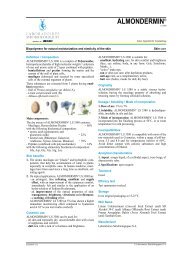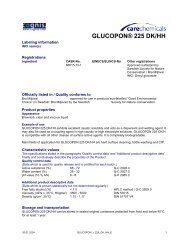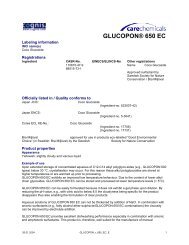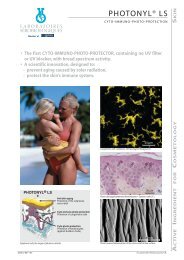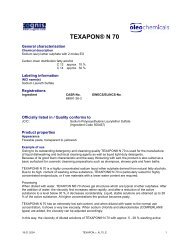Create successful ePaper yourself
Turn your PDF publications into a flip-book with our unique Google optimized e-Paper software.
A3<br />
C1<br />
E<br />
D<br />
Member of<br />
IL1<br />
LTB4<br />
PNN<br />
+<br />
Macrophage<br />
Activation<br />
Attraction<br />
O 2 °<br />
Collagenase<br />
Elastase<br />
<strong>PROTEASYL®</strong> <strong>TP</strong> <strong>LS</strong> <strong>8657</strong><br />
BOTANICAL ANTI-ENZYME COMPLEX<br />
FOR FIRMNESS AND ELASTICITY<br />
A1 A2<br />
C2<br />
Elastic<br />
fibers<br />
50 µm<br />
Collagen<br />
Peptidic<br />
fragments<br />
© Pictures Laboratoires Sérobiologiques<br />
Epidermal<br />
proteases<br />
Chymotrypsin like<br />
SCD<br />
Plasmin<br />
(plasminogen)<br />
P.A. SCC<br />
Cathepsin B<br />
Cathepsin D<br />
Physiology Stress &<br />
pathology<br />
Fig. 1 – <strong>PROTEASYL®</strong> <strong>TP</strong> <strong>LS</strong> <strong>8657</strong> = Nature, Origin, Field of<br />
activity, Effects.<br />
A = At the dermal level, the integrity of the protein network (elastic<br />
and collagen fibers) results from a balance between the rates<br />
of proteases (elastase, collagenase) and their inhibitors:<br />
- A1: illustrates young skin,<br />
- an aged skin (A2) is, on the contrary, characterized by a<br />
degradation of the elastic and collagen network (excess of<br />
proteases and deficiency of inhibitors) resulting in a loss of<br />
tonicity and suppleness (see mechanism = A3).<br />
D = dermis, E = epidermis<br />
B = At the epidermal level, skin's attacks induce an activation of<br />
the proteases, leading to cell damage (mechanism).<br />
C = <strong>PROTEASYL®</strong> <strong>TP</strong> <strong>LS</strong> <strong>8657</strong> is a peptide obtained by extraction and<br />
purification from Pisum sativum L.<br />
<strong>8657</strong>SO-801-121 © LABORATOIRES SÉROBIOLOGIQUES / COGNIS FRANCE S.A.<br />
B<br />
E<br />
D<br />
P.A.<br />
Plasminogen<br />
plasmin<br />
Cathepsin H<br />
SG<br />
SS<br />
SB<br />
Cathepsin G (PNN)<br />
GL<br />
GKH<br />
FK<br />
HD<br />
N<br />
N<br />
N<br />
ECC<br />
FK<br />
MB<br />
Desquamation Desquamation<br />
disorders<br />
Terminal<br />
differentiation<br />
Maturation<br />
Migration<br />
50 µm<br />
Acantholysis<br />
Intracellular<br />
proteolysis<br />
Epidermal<br />
detachment<br />
© Pictures Laboratoires Sérobiologiques<br />
ACTIVE INGREDIENT FOR COSMETOLOGY SKIN
ACTIVE INGREDIENT FOR COSMETOLOGY SKIN<br />
Skin proteases and anti-proteases<br />
1. Skin proteases<br />
Proteases are enzymes which can degrade proteins by<br />
hydrolysis into peptides and constitutive amino acids.<br />
They can be divided into exopeptidases and endopeptidases,<br />
and into intra- and extracellular proteases.<br />
1.1 Proteases in normal skin<br />
• Dermal proteases<br />
Dermal proteases renew structural proteins: elastic fibers<br />
and collagen of the extracellular matrix via the action of<br />
fibroblastic collagenases and elastases.<br />
• Epidermal proteases (Fig. 1C)<br />
These proteases play a fundamental role in epidermal cell<br />
differentiation, desquamation and moisturization.<br />
1.2 Activation of skin proteases during aggressions<br />
Skin aggressions (UV, chemical, immunological…) and cutaneous<br />
inflammation induce a major increase in proteases.<br />
• Dermal proteases (Fig. 1B)<br />
Polynuclear neutrophils (PNNs) activated by the inflammation<br />
secrete proteases (collagenase, elastase) lysing collagen<br />
and elastin. The released peptides, along with other factors<br />
(IL1, LTB4) also attract and activate PNNs and macrophages;<br />
the lytic reaction is boosted.<br />
• Epidermal proteases (Fig. 1C)<br />
The abnormally activated proteases cause some disturbances<br />
in normal desquamation, differentiation and moisturization.<br />
In advanced cases, an acantholysis (extrakeratinocytary<br />
lysis by destruction of the intercellular links leading the<br />
separation of the stratum spinosum cells) or an intrakeratinocytary<br />
proteolysis may be observed.<br />
2. Inhibitors of skin proteases<br />
The narrow balance between proteases and their respective<br />
more or less specific inhibitors, contributes to the balance<br />
between formation and turnover of cells and biomolecules<br />
within the extracellular spaces of the various cutaneous<br />
areas: hypodermis, dermis, epidermis, horny layers.<br />
Proteasic inhibitors play an essential role in the regulation<br />
of many physiological processes.<br />
3. Protease/protease inhibitor imbalance:<br />
3.1 During skin aging [1, 2] (Fig. 1 B)<br />
A rarefaction and a degradation of the dermal elastic<br />
network can be observed. The main causes are:<br />
- a decrease of the biosynthetic activity of elastin and<br />
collagen by fibroblasts,<br />
- an increase of elastolysis due to a relative increase of the<br />
elastasic and collagenasic activities and to a reduction of<br />
the natural inhibitors of elastase and collagenase.<br />
The quantity of dermal collagen having strongly decreased,<br />
the ratio between collagen biosynthesis and its degradation<br />
by collagenases becomes negative with age. The<br />
result is a predominance of catabolytic activities.<br />
In photoexposed areas, collagenases are especially activated<br />
(via cytokines and prostaglandins) and poor quality of<br />
(non cross-linked) non-functional elastin accumulates.<br />
The receptors of fibroblasts become less interdependent<br />
on the elastic fibers and the collagen of the extracellular<br />
matrix, hence a decrease of skin elasticity and tonicity.<br />
3.2 During skin aggressions (Fig. 1 C)<br />
Activation of skin proteases due to acute environmental<br />
aggressions may cause major skin damages [3] . The<br />
repetition of such aggressions and the resulting proteolytic<br />
damages contribute to skin aging.<br />
<strong>PROTEASYL®</strong> <strong>TP</strong> <strong>LS</strong> <strong>8657</strong><br />
CONCEPT OF ANTI-PROTEASES<br />
Certain proteases inhibitors (elastase, collagenase, trypsin,<br />
cathepsin, plasmin…) offer interesting features. When in<br />
excess, they contribute to skin aging and damage by<br />
environmental aggressions.<br />
The permanent remodeling of the skin requires a narrow<br />
balance between dermal and epidermal proteases and their<br />
inhibitors.<br />
PROTEASYL<br />
Fig. 2 – Schematic representation of the dermal and epidermal anti-protease<br />
balance that led to the concept of <strong>PROTEASYL®</strong> <strong>TP</strong> <strong>LS</strong> <strong>8657</strong>.<br />
DEFINITION / COMPOSITION<br />
<strong>PROTEASYL®</strong> <strong>TP</strong> <strong>LS</strong> <strong>8657</strong> is a new anti-protease extracted<br />
from seeds of Pisum sativum L. (peas). First grown in the<br />
Near East, pea has been domesticated since Antiquity.<br />
<strong>PROTEASYL®</strong> <strong>TP</strong> <strong>LS</strong> <strong>8657</strong> is a botanical peptidic active<br />
ingredient, prepared according to an exclusive extraction/<br />
purification technology. <strong>PROTEASYL®</strong> <strong>TP</strong> <strong>LS</strong> <strong>8657</strong> is supplied<br />
as a ready-to-use concentrated hydrosolute.<br />
® <strong>TP</strong><br />
<strong>LS</strong> <strong>8657</strong><br />
SKIN BENEFITS<br />
1. Anti-elastase, anti-collagenase and anti-free radicals<br />
properties.<br />
2. Protector of dermal proteins: anti-aging effect.<br />
Protects collagen and elastin against the deleterious<br />
effects of proteases activated during aging and stress.<br />
<strong>PROTEASYL®</strong> <strong>TP</strong> <strong>LS</strong> <strong>8657</strong> strengthens the activity rate<br />
of protease inhibitors, helping to restore the balance<br />
between proteases and anti-proteases (Fig. 2).<br />
3. Protection and repair of epidermal proteins.<br />
Against damages induced by proteases activated by<br />
environmental aggressions (pollution, stress, UV…).<br />
4. Strengthening skin elasticity.<br />
Anti-aging effect for slackened, atonic skin.<br />
5. Long-lasting hydroregulator.<br />
Intervening according to a unique mechanism of action:<br />
inhibition of an excess of proteases within horny layers [4] .<br />
COSMETIC USE<br />
<strong>PROTEASYL®</strong> <strong>TP</strong> <strong>LS</strong> <strong>8657</strong> can be used for:<br />
- anti-age, protecting, repairing, skin defense care,<br />
- elastifying, firming, moisturizing care,<br />
- soothing, anti-irritating, anti-stressed skin, sun care,<br />
- body care (stretch marks).<br />
DOSAGE / SOLUBILIT Y / MODE OF INCORPORATION<br />
1. Dose of use: 3 to 10%.<br />
2. Solubility: soluble in water and insoluble in oils.<br />
3. Mode of incorporation: <strong>PROTEASYL®</strong> <strong>TP</strong> <strong>LS</strong> <strong>8657</strong> is<br />
incorporated into the finishing process at 45°C, or at room<br />
temperature for cold processing.<br />
ANALY TIC AL CHARACTERISTICS<br />
1. Aspect: light yellow limpid liquid, with a weak odor.<br />
2. Specifications: upon request.<br />
TOLERANCE<br />
Good.<br />
EFFIC ACY<br />
Test summaries hereafter.<br />
STORAGE<br />
In its original packaging, at 15 - 25°C.<br />
INCI NAME<br />
Pisum Sativum (Pea) Extract.<br />
MANUFACTURER<br />
Laboratoires Sérobiologiques / Cognis France S.A.<br />
[1] Robert et al.: Aging of Connective tissues. General considerations in “Frontiers of matrix biology”.<br />
S. Karger, Basel - Vol. 1, 1-45, 1973<br />
[2] Bouissou et al.: Cutaneous aging. Its relation with arterio-sclerosis and atheroma. In “Frontiers<br />
of matrix biology”. S. Karger, Basel - Vol. 1, 190-211, 1973<br />
[3] Eaglstein (W.H.) et al.: Ultraviolet radiation induced inflammation and leukocytes.<br />
J. Invest. Dermatol., 72, 59-63, 1979<br />
[4] Kitamura (K.) et al.: Research on the mechanism by which dry skin occurs and the development<br />
of an effective compound for its treatment. In 18 th IFSCC Congress, Venezia - Italy - Vol. 1,<br />
131-166, 1994<br />
<strong>8657</strong>SO-801-121 © LABORATOIRES SÉROBIOLOGIQUES / COGNIS FRANCE S.A.<br />
Young<br />
skin<br />
Balance<br />
Aged<br />
skin<br />
Stressed<br />
skin<br />
Aged and/or<br />
stressed skin<br />
+ PROTEASYL ®<br />
<strong>TP</strong> <strong>LS</strong> <strong>8657</strong><br />
Proteases: elastase,<br />
collagenase, plasmin,<br />
cathepsin...<br />
Protease inhibitors
PLASMIN INHIBITION (IN VITRO)<br />
Aim / Protocol<br />
Demonstration of the anti-plasmin effect of <strong>PROTEASYL®</strong> <strong>TP</strong><br />
<strong>LS</strong> <strong>8657</strong>. Plasmin is an epidermal serine protease, activated<br />
during skin aggressions. It induces epidermal destruction<br />
and acantholysis (= extra-keratinocyte lysis by destruction<br />
of the intercellular links leading to separation of stratum<br />
spinosum cells).<br />
The effect of <strong>PROTEASYL®</strong> <strong>TP</strong> <strong>LS</strong> <strong>8657</strong> was studied on human<br />
skin, and visualized by histological staining of skin cross<br />
sections.<br />
Untreated control<br />
Fig. 3 – Experimental protocol to study the anti-proteasic effect of <strong>PROTEASYL®</strong><br />
<strong>TP</strong> <strong>LS</strong> <strong>8657</strong> in solution at 10% on epidermis.<br />
Results (Fig. 4)<br />
Skin sections<br />
with cryostat<br />
Plasmin<br />
Dry at 37°C during 3 hours<br />
Histological staining<br />
Microscopic observation<br />
Acantholysis (= extra-keratinocyte lysis)<br />
Plasmin +<br />
10% PROTEASYL ® <strong>TP</strong> <strong>LS</strong> <strong>8657</strong><br />
Conclusion<br />
Plasmin induces epidermal alterations ranging from minimal<br />
extra-keratinocyte lysis and acantholysis to total destruction<br />
of the epidermis.<br />
<strong>PROTEASYL®</strong> <strong>TP</strong> <strong>LS</strong> <strong>8657</strong> at 10% almost completely<br />
neutralized the deleterious action of plasmin: skin treated<br />
with <strong>PROTEASYL®</strong> <strong>TP</strong> <strong>LS</strong> <strong>8657</strong> preserves its normal cell<br />
organization.<br />
ANTI-ELASTASE ACTIVITY ON HUMAN SKIN (EX VIVO)<br />
Aim<br />
Elastases are proteases that specifically destroy the network<br />
of elastic fibers, at a neutral pH.<br />
Skin aging generally appears at around 40-50 years old and<br />
is characterized by:<br />
- an increase in the elastase activity of dermal fibroblasts,<br />
- a decrease in the concentration of elastase inhibitors regulating<br />
the turnover of elastic tissue.<br />
Thus, a degradation of the dermal elastic network causes<br />
a deterioration of the functional properties of the skin:<br />
elasticity, suppleness and tonicity.<br />
Protocol (Fig. 5)<br />
Human skin biopsies.<br />
Treatment:<br />
- untreated control,<br />
- elastase,<br />
- elastase + 5% <strong>PROTEASYL®</strong> <strong>TP</strong> <strong>LS</strong> <strong>8657</strong>.<br />
Incubation during 2 hours.<br />
Staining by the Weigert's technique.<br />
Optical microscopy + image analysis.<br />
Results (Fig. 6)<br />
For a dose of elastase causing complete disappearance of<br />
elastic fibers, the addition of 5% <strong>PROTEASYL®</strong> <strong>TP</strong> <strong>LS</strong> <strong>8657</strong><br />
significantly preserved:<br />
- 50% of the papillary elastic fibers,<br />
- 35% of the reticular elastic fibers.<br />
Conclusion<br />
<strong>PROTEASYL®</strong> <strong>TP</strong> <strong>LS</strong> <strong>8657</strong> exhibited a good anti-elastase<br />
activity on skin.<br />
EFFIC ACY TESTS<br />
Fig. 4 – Histological illustration of the effect of <strong>PROTEASYL®</strong> <strong>TP</strong> <strong>LS</strong> <strong>8657</strong> as<br />
an inhibitor of an excess of plasmin on human epidermis. Anti-stress effect.<br />
A - Untreated control area.<br />
B - Area treated with plasmin alone: destruction of the epidermis.<br />
C - Area treated with plasmin + 10% <strong>PROTEASYL®</strong> <strong>TP</strong> <strong>LS</strong> <strong>8657</strong>: perfect preservation<br />
of the epidermis. E = epidermis, D = dermis.<br />
<strong>8657</strong>SO-801-121 © LABORATOIRES SÉROBIOLOGIQUES / COGNIS FRANCE S.A.<br />
A<br />
B<br />
E<br />
C<br />
E<br />
E<br />
D<br />
D<br />
D<br />
Fig. 5 – Protocol.<br />
A<br />
E<br />
B<br />
E<br />
C<br />
E<br />
PD<br />
PD PD<br />
RD<br />
RD<br />
Skin sections<br />
Incubation<br />
With Elastase + With Elastase<br />
<strong>PROTEASYL®</strong> <strong>TP</strong> alone<br />
<strong>LS</strong> <strong>8657</strong> at 5%<br />
Optical Optical<br />
microscope microscope<br />
+ +<br />
Image Image<br />
analyzer analyzer<br />
RD<br />
Fig. 6 – Cross section of human skin illustrating the protecting effect of 5%<br />
<strong>PROTEASYL®</strong> <strong>TP</strong> <strong>LS</strong> <strong>8657</strong> against the destroying effect of elastase on the dermal<br />
network. Three experimental conditions A, B and C:<br />
A: Untreated control area: integrity of the dermal elastic network.<br />
B: Skin treated with the elastase enzyme alone: almost total destruction of the<br />
elastic network.<br />
C: Skin treated by elastase + 5% <strong>PROTEASYL®</strong> <strong>TP</strong> <strong>LS</strong> <strong>8657</strong>: good preservation of<br />
the papillary and reticular dermal elastic network.<br />
E = epidermis, PD = papillary dermis, RD = reticular dermis.<br />
ACTIVE INGREDIENT FOR COSMETOLOGY SKIN
ACTIVE INGREDIENT FOR COSMETOLOGY SKIN<br />
MOISTURIZING ACTIVITY ON THE HORNY LAYER OF<br />
HUMAN SKIN (EX VIVO)<br />
Aim<br />
Evaluation of the moisturizing effect of <strong>PROTEASYL®</strong> <strong>TP</strong> <strong>LS</strong> <strong>8657</strong><br />
by measurements of dielectric conductivity on the horny layer<br />
(stratum corneum) of human skin (Tagami's method).<br />
Protocol<br />
Skin biopsies: the epidermis is separated from the dermis<br />
and the horny layer is isolated.<br />
The samples of horny layer are tested under 3 differents<br />
conditions:<br />
- untreated, control area,<br />
- area treated with a placebo gel,<br />
- area treated with a gel containing 5% <strong>PROTEASYL®</strong> <strong>TP</strong><br />
<strong>LS</strong> <strong>8657</strong> (1 mg/cm2 ).<br />
Three treatments with the hydrogels have been made within<br />
30 minutes of interval. Conductivity measurements were<br />
made up to 24 hours after the last application in standard<br />
conditions (t = 20°C, RH = 40%).<br />
Results (Fig. 7)<br />
IMPROVEMENT OF SKIN ELASTICITY (CLINICAL STUDY)<br />
Aim / Protocol<br />
The improvement of skin elasticity with a cream containing<br />
3% <strong>PROTEASYL®</strong> <strong>TP</strong> <strong>LS</strong> <strong>8657</strong> was compared to that of a placebo<br />
cream.<br />
Double blind clinical study in 10 female volunteers from<br />
51 to 65 years old, having a slackened skin with a loss of<br />
elasticity on the external side of the arms and forearms.<br />
Twice daily randomized treatment for 3 weeks:<br />
- placebo cream on one side,<br />
- cream with 3% <strong>PROTEASYL®</strong> <strong>TP</strong> <strong>LS</strong> <strong>8657</strong> on the other side.<br />
Quantitative measurements of skin elasticity by vertical extensiometry<br />
(Cutometer) after repeated constraints. Comparative<br />
study of the effect of <strong>PROTEASYL®</strong> <strong>TP</strong> <strong>LS</strong> <strong>8657</strong> 12 hours and<br />
24 hours after the last application, after the 3 weeks of treatment.<br />
Results (Fig. 8)<br />
Aim<br />
Laboratoires Sérobiologiques have<br />
developed an exclusive device to evaluate<br />
skin firmness, based on the<br />
cutimeter’s model: the dermofirmometer.<br />
This device looks like a skin fold clipper,<br />
it is equipped with a sensor position<br />
measuring the skin fold thickness<br />
and then calculating its compressibility,<br />
related to skin firmness.<br />
Clipper<br />
(dermofirmometer)<br />
Protocol<br />
Double blind clinical study on 10 female volunteers, aged<br />
from 46 to 64 years old, having a loss of skin firmness on their<br />
forearms.<br />
Bi-daily randomized treatement during 6 weeks, in the<br />
morning and in the evening, with:<br />
- a placebo cream on one forearm,<br />
- a cream containing 5% <strong>PROTEASYL®</strong> <strong>TP</strong> <strong>LS</strong> <strong>8657</strong> on the<br />
other forearm.<br />
The cutaneous compressibility was evaluated before and<br />
after the 6 weeks of treatment, with the dermofirmometer.<br />
Skin<br />
Skin fold formed by the<br />
compression of the 2 jaws<br />
% increase of dielectric conductivity versus control<br />
Fig. 7 – Moisturizing effect of <strong>PROTEASYL®</strong> <strong>TP</strong> <strong>LS</strong> <strong>8657</strong> versus placebo. Kinetics<br />
of the activity over 24 hours.<br />
Improvement (%)/D0<br />
20<br />
D21 T12 D21 T24<br />
Fig. 8 – <strong>PROTEASYL®</strong> <strong>TP</strong> <strong>LS</strong> <strong>8657</strong>: strengthening effect of skin elasticity versus<br />
placebo.<br />
HEADQUARTERS: LABORATOIRES SÉROBIOLOGIQUES / COGNIS FRANCE S.A. - 3, RUE DE SEICHAMPS - BP40 - F-54425 PULNOY (FRANCE) - FAX. 03.83.29.98.65 - TEL. 03.83.29.97.91<br />
<strong>8657</strong>SO-801-121 © LABORATOIRES SÉROBIOLOGIQUES / COGNIS FRANCE S.A.<br />
15<br />
10<br />
5<br />
0<br />
(NS)<br />
(**)<br />
+14.6%<br />
Placebo cream<br />
Cream containing 3% of<br />
PROTEASYL ® <strong>TP</strong> <strong>LS</strong> <strong>8657</strong><br />
D0 = before treatment<br />
D21 = after 3 weeks of treatment<br />
Statistics:<br />
Average of 10 tests - 1 factor Anova<br />
(*) Sign. PROTEASYL ® <strong>TP</strong> <strong>LS</strong> <strong>8657</strong> / control<br />
p



